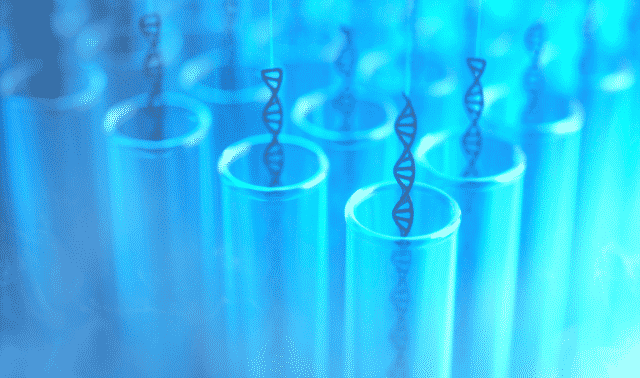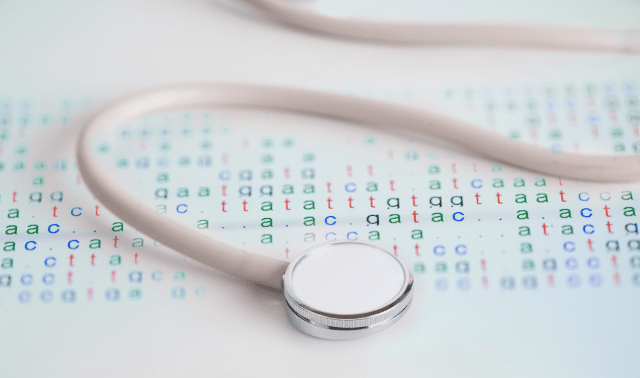Sign up for the Family Tree Newsletter Plus, you’ll receive our 10 Essential Genealogy Research Forms PDF as a special thank you!
Get Your Free Genealogy Forms
"*" indicates required fields
Our collective understanding of genetics has evolved quite a bit in the past few decades. Thanks to advancements in DNA technology, genealogists have more options than ever for uncovering their genetic ancestry. They enjoy both a wider variety of DNA tests that they can take, as well as a larger number of services that offer DNA testing.
Family historians can take advantage of three types of DNA tests. We’ll cover each in this article:
- Autosomal DNA (atDNA)
- Mitochondrial DNA (mtDNA)
- Y-chromosomal DNA (Y-DNA)
Note: A fourth type of DNA, X-chromosomal (X-DNA) is also useful for genealogists. We’ve omitted it from this list because no testing companies offer X-DNA tests as of this writing. Instead, X-DNA information is sometimes included as part of atDNA results.
ADVERTISEMENT
The basic process for testing all three types of DNA is the same:
- Purchase a DNA kit from a trustworthy service
- Collect a sample, usually by spitting in a tube or swabbing your cheek
- Return the kit by mail to the testing company
- Receive and review your results, which are usually ready within six to 10 weeks
DNA Tests at a Glance
| Who can test | Which ancestors you can learn about by testing | Typical cost | |
| autosomal DNA (atDNA) | Anyone | All genetic ancestors, usually within the past five or six generations | $40–$100 |
| mitochondrial DNA (mtDNA) | Anyone | Strict maternal lines: mother, mother’s mother, mother’s mother’s mother, etc. | $160 |
| Y-chromosomal DNA (Y-DNA) | Genetic males only | Strict paternal lines: father, father’s father, father’s father’s father, etc. | $120–$450 |
The table above compares key features of the three commercially available kinds of DNA tests.
In short: Most genealogists will want to take an atDNA test, since atDNA is the most versatile kind of DNA and the least expensive to test. But there are specific cases in which someone might want to take an mtDNA or Y-DNA test.
ADVERTISEMENT
Genetics 101

DNA is organized into structures called chromosomes. Humans have 23 pairs of chromosomes, and receive one copy of each chromosome from each parent. The “autosomes” make up 22 of those pairs.
The 23rd pair—made up of some combination of X and Y chromosomes—are called the “sex chromosomes.” People also receive one chromosome of this pair from each parent: the X chromosome from their mother, and either an X or a Y chromosome from their father. The DNA on the X and Y chromosomes is genealogically relevant, but generally tested separately from the DNA on autosomes.
Some people receive too many (or too few) chromosomes from their parents, resulting in chromosomal abnormalities. Trisomy 21 (better known as Down syndrome), for example, occurs when a child receives a third copy of chromosome 21.
Because each child inherits DNA from their ancestors, DNA tests can reveal clues about heritage.
atDNA: What is Autosomal DNA?
atDNA tests examine segments of your 22 autosomal chromosomes. They report on the amount of DNA your sample shares with other test takers as well as with certain “reference populations” from around the world. Then the company generates your DNA results in two primary forms:
- Ethnicity estimates: An algorithm-based representation of where your ancestors are likely to have originated, usually reported as a percentage (e.g., “53% German” or “12% Native American”)
- DNA matches: A list of other test takers with whom you share DNA, usually reported as a relationship estimate (e.g., “1st–2nd cousin”) that’s based on the amount of DNA you share
You inherit atDNA from both your father and mother, so you can learn information about ancestors on both sides of your family. That fact makes atDNA tests incredibly valuable for genealogy, although (due to mutation, recombination, and the fact that each generation only passes on about 50% of their DNA to their children) atDNA is only reliable for learning about the past five or six generations of your family. And you won’t necessarily know which pieces of DNA came from which ancestors.
Because of its utility, atDNA is by far the most commonly tested type of DNA. Most of the tests offered by companies in the DNA testing space are atDNA tests (even if they’re not marketed as such). And atDNA testing has been the driving force behind the rise of commercial DNA testing.
More people have taken atDNA tests than any other kind of test combined, meaning you’re more likely to find relatives in the massive databases that companies like AncestryDNA and MyHeritage DNA have amassed. atDNA companies have also been innovating at a fast rate, pushing out new tools and releasing frequent tweaks to their results.
atDNA tests tend to be much cheaper than their mtDNA and Y-DNA counterparts (making them more accessible), and consumers have more testing companies to choose from. You can also often transfer your raw DNA from one company to another, allowing you to test once, but have access to multiple companies’ tools and DNA match databases.
Note: Some atDNA tests also provide information on X-chromosomal DNA (X-DNA).
What you can do with autosomal DNA (atDNA)
- Determine relationships between test takers who have shared ancestors within the past five or so generations
- Study the geographic origins of a family within the past 300 years using “ethnicity estimates” and tools like migration groups
- Connect with living DNA relatives
- Reconstruct genetic family trees using artificial intelligence, online family trees, and match information
- Receive health-related information, such as if you have genes associated with particular traits or are at heightened risk to develop certain diseases or disorders
- Find birth relatives for adoptees and others who have unknown parentage
Companies that offer atDNA testing
mtDNA: What is Mitochondrial DNA?
In addition to atDNA, your cells also contain DNA in their mitochondria, the “powerhouses of the cell” that produce energy. Mitochondrial DNA is different from the 23 pairs of chromosomes in each cell’s nucleus, and is passed on from mother to child. (Note: Children do not inherit any mtDNA from their fathers.)
Because mtDNA is passed from mother to child, it can only give you information about your direct maternal line:
- your mother
- your maternal grandmother
- your maternal grandmother’s mother
- (and so on)
mtDNA changes relatively little from generation to generation. This is both a blessing and a curse for genealogists. On the one hand, it means that mtDNA tests can give you information about your maternal line many generations ago—potentially far more than the five or so accessible via atDNA testing.
On the other hand, mtDNA test results can’t provide specific information about how you’re related to your matches. Rather, they report on what mutations you and other test takers have from a standard reference genome. If you have the same mutations at the same locations, you likely share a maternal ancestor within the past several generations. But your results can’t indicate who that shared ancestor was, or how you and another test taker are related.
What you can do with mitochondrial DNA (mtDNA)
- Establish shared ancestry with others along your maternal line
- Study the “deep history” of your maternal line using haplogroups
Companies that offer mtDNA testing
Family Tree DNA is the only mainstream company that offers full mtDNA testing. 23andMe and Living DNA both run some mtDNA analysis and allow test takers to view their haplogroup, but don’t include match information. (23andMe does, however, let you view your raw mtDNA data.)
Y-DNA: What is Y-Chromosomal DNA?
While atDNA tests examine the 22 pairs of autosomes, Y-DNA tests examine the Y chromosome—one of the two “sex chromosomes” that can make up the 23rd pair.
Similar to mtDNA (which is passed from mothers to their children), Y-DNA is passed exclusively from fathers to sons. As a result, Y-DNA tests can only give you information about your direct paternal line:
- your father
- your paternal grandfather
- your paternal grandfather’s father
- (and so on)
This inheritance pattern is especially useful to genealogists, since many cultures pass surnames down strictly paternal lines. However, Y-DNA changes very little between generations, making it difficult to determine how recently two test takers share a common ancestor.
Only genetic males can take Y-DNA tests, as only they have Y chromosomes. Women hoping to get information about their paternal lines will need to find eligible male relatives (such as brothers, paternal uncles or certain male cousins) to test on their behalf.
Y-DNA results report on the number of differences you and matches have between the tested segments of DNA. Like mtDNA results, they don’t include estimates for how you’re related to matches—only that you probably share a paternal ancestor at some point in the past several generations. You’ll have to infer a more-specific relationship using other resources.
Note that Y-DNA tests are not designed to prove paternity. You would need both a son and his possible father to test with the same company—and even then, results would only conclude that they share a paternal ancestor within the past several generations.
What you can do with Y-chromosomal DNA (Y-DNA)
- Establish shared ancestry with others along your paternal line
- Trace the history of a particular surname
- Study the “deep history” of your paternal line using haplogroups
Companies that offer Y-DNA testing
Family Tree DNA is the only of the large companies to offer full Y-DNA testing, and it has a few options: Y-37, Y-111, and Y-700 (also called “Big-Y”). The numbers in each test name refer to how much DNA is tested; higher numbers tested correspond to more-precise results.
23andMe and Living DNA each provide a paternal haplogroup for male test takers, but do not offer other Y-DNA results.
Further Reading
- DNAeXplained: A blog from expert Roberta Estes, who breaks down complex DNA topics and shares the latest genetic genealogy news
- The Family Tree Guide to DNA Testing and Genetic Genealogy, second edition by Blaine T. Bettinger (Family Tree Books): Last updated in 2019, this comprehensive guide discusses the various kinds of DNA tests, plus strategies for understanding and applying your DNA results from the major testing companies
- International Society of Genetic Genealogy Wiki: A collection of expertly written articles on important DNA topics
- Your DNA Guide: Family Tree Magazine contributor Diahan Southard creates plain-spoken DNA explainers and offers consulting services
More from Family Tree Magazine
Last updated, June 2023.
FamilyTreeMagazine.com is a participant in the Amazon Associates Program, an affiliate advertising program. It provides a means for this site to earn advertising fees, by advertising and linking to Amazon and affiliated websites.
ADVERTISEMENT











